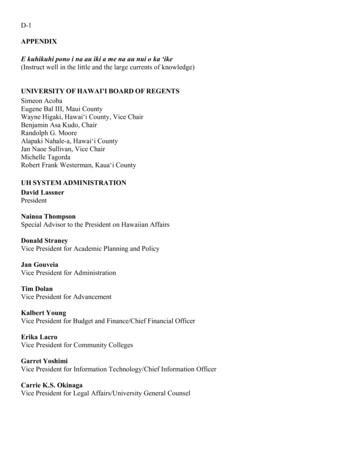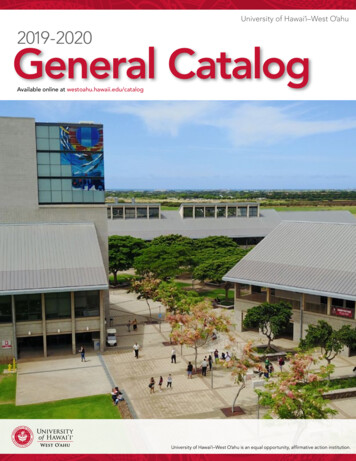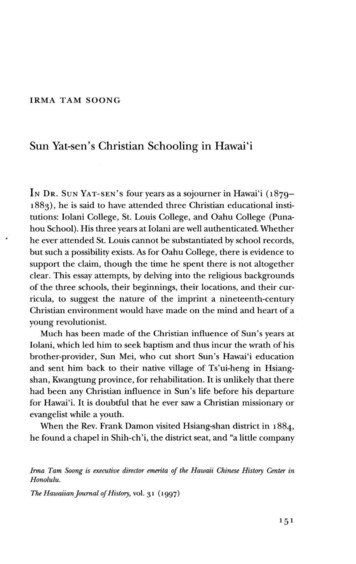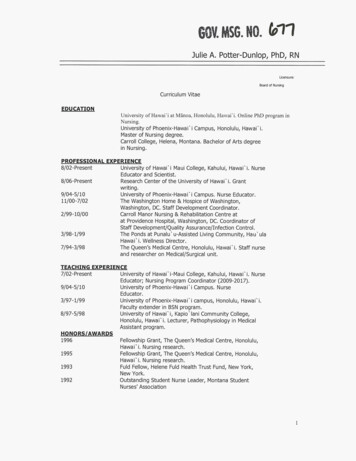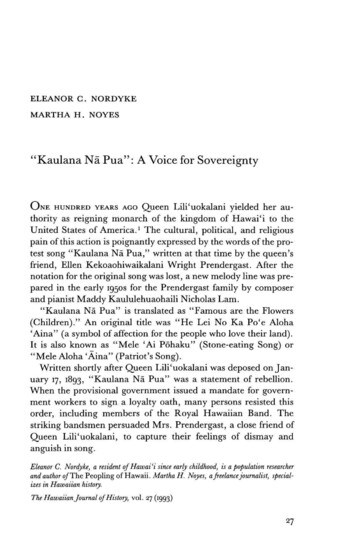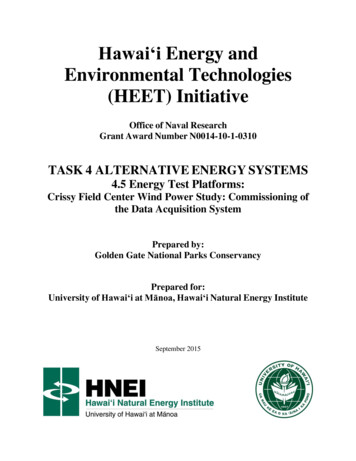
Transcription
Hawai‘i Energy andEnvironmental Technologies(HEET) InitiativeOffice of Naval ResearchGrant Award Number N0014-10-1-0310TASK 4 ALTERNATIVE ENERGY SYSTEMS4.5 Energy Test Platforms:Crissy Field Center Wind Power Study: Commissioning ofthe Data Acquisition SystemPrepared by:Golden Gate National Parks ConservancyPrepared for:University of Hawai‘i at Mānoa, Hawai‘i Natural Energy InstituteSeptember 2015
rStudyHNEISubcontract,PrimeAwardNo.N00014- ‐10- ‐1- ‐0310GoldenGateNationalParksConservancy9/28/2015
Crissy Field Center Wind Power StudyDeliverable 6September 28, 2015BackgroundThe following summarizes the performance of the Data Acquisition System (DAS) forthe Crissy Field Center wind turbine performance monitoring. This report includesdocumented evidence of installation and commissioning of the DAS including HNEIverification of availability of real-time data. This report also includes lessons learned thatmay be applicable to future projects.
Crissy Field Center Wind Power StudyDeliverable 6September 28, 20151.ExistingSystemThe DAS monitors wind turbine performance and also building performance. Thecomponents specific to wind turbine performance monitoring include wind speed anddirection sensors mounted at the center turbine location as well as at the roof of the cafe,and power monitoring sensors on each wind turbine power circuit. Hardware componentsof the system are indicated in the as-built system diagrams (see Appendix A, As-BuiltDrawings).For wind speed and direction at the center turbine, the sensors are connected to amicrocontroller. This microcontroller is powered through wired low voltage power fromthe building and communicates via zigbee radio transmission to a receiver located nearthe cafe weather station, which is then in turn wired to the controller. The microcontrollerlocated at the wind instrument holds 60 1-second interval measurements in memory,wrapping around so that the oldest readings are overwritten by the newest readings. Thecontroller keeps time; every minute it sends a request via a serial call to themicrocontroller. When prompted by a serial call, the microcontroller calculatesminimum, maximum, mean, and standard deviation of the two datasets, and returns thesesummary statistics via serial connection. A vector average is used for the mean of winddirection. Observed response times have varied between about 1 and 6 seconds. Data arelogged in flash memory at the controller.For power, each wind turbine circuit is monitored using current transformers andreference voltage that are wired to an electrical monitoring device to calculate power use.Within 1 second of the anemometer request, the controller sends requests to the electricalmonitoring device for current power use on each wind turbine circuit. The electricalmonitoring device responds with current power readings. Response time is within 1second. The controller logs these readings in its flash memory.Data accumulated in flash memory is retrieved approximately monthly via manual FTPrequest. First, the file is archived with a date-specific prefix. Then this archived file isdownloaded via FTP. A custom script is run to consolidate data into rows correspondingto the given time stamp. Both the original data file and the consolidated ("pivoted") datafile are uploaded to a web server for distribution ex.html).The DAS for the building operates on a 10-minute interval and also reports power datafor each individual turbine. These data are collected and processed automatically and areultimately visualized using a custom dashboard interface that shows data in real time (seeAppendix B, Dashboard Screenshots). This visual representation of the data has beenhelpful for assessing whole building performance, and it has also been helpful foridentifying issues with wind turbine performance since it provides a quick way to see if
Crissy Field Center Wind Power StudyDeliverable 6September 28, 2015wind turbines are producing power when wind is available. Several times during theproject, the dashboard helped alert the team to issues with wind turbines.
Crissy Field Center Wind Power StudyDeliverable 6September 28, 20152.LessonsLearned&RecommendationsSeveral issues arose in the commissioning and ongoing operation of the DAS. Theseinclude the following issues: Wind speed readings tended to be less than expected. Replacement of ananemometer unit at the rooftop of the café helped identify a likely issue withanemometer calibration for each original anemometer. Using a statistical analysisof anemometer readings before and after the replacement of this anemometer, weidentified a correction factor that could be applied to the anemometer at the windturbines to correct the calibration (see Appendix C, Anemometer CorrectionFactor memo). Even after the correction, the wind speed readings still tended tobe lower than what was expected from a previously completed site survey. Wind turbines and inverters were expected to be producers of electricity, notconsumers. The Tangerie turbine unit appeared to be producing a constant outputof 20W. However, an analysis of Tangerie output compared with Windspireoutput revealed that this 20W was most likely 20W of electrical use on theTangerie circuit (see Appendix D, Power Production of North Windspire andTangerie Turbines, November 1–17, 2012). It is unclear whether the source of this20W load was the inverter or another load on the same circuit.The Hawaii Natural Energy Institute (HNEI) was able to receive the data collected fromthe DAS. HNEI completed an analysis of this data, during which process they collectednotes on lessons learned. In particular, they identified issues as they attempted to extractperformance curves from the wind and wind turbine data. The primary issue was that thepower use and wind data didn’t show a strong relationship at the level of the mostdetailed data collected due to the timing and nature of readings. Instantaneous powerreadings and 1-minute averaged wind data demonstrated wind turbine performance overtime, but the analysis team found they wanted more detailed data that showedperformance at a 1-second sample interval. Other issues were identified as well, andinclude gaps in the data and a bug in data processing software that omits or duplicates aline of data at the edges of monthly datasets.HNEI provided a series of recommendations for the next phase of the project to addressissues identified in the first phase. Their recommendations are as follows: Data Acquisitiono We would like to record wind and energy data in synchronized 1 Hzintervals.o With 1 hz data for wind and turbine output, we would not require additionalpre-processing (min, max, ave, std dev)o Synchronize time stamps across all sensors in DAQ.
Crissy Field Center Wind Power StudyDeliverable 6oo September 28, 2015Anemometers localized to each turbine, 1 anemometer per turbineIdentify sources of false signals (e.g., 10-20W signal from non-performingTangarie)Data Processingo Missing data: large amount of missing data in existing data files. Troubleshoot sources of missing data E.g., Network, internet, archiving, instrumentation,communication, inverter, connection, logging, etc.o Request direct access to raw datao Data formatting consistent across sub reports (monthly)o Eliminate redundant reporting across sub reports (monthly); doublereporting of same timestamps on different reports show different data
Crissy Field Center Wind Power StudyDeliverable 6AppendixA:As- ‐BuiltDrawingsSeptember 28, 2015
TDTSTAPlenum and floor surface temperature : sensors are under floorDuct air temperature : sensor is inserted through a hole in duct and sealedWall-mounted air and surface temperature : Includes a wall-mounted air temperature sensor (described above), and also includes a surfacetemperature sensor : drill hole in drywall; drill hole in base of wall and floor; run cable from under floor to sensor location; secure sensor inhole; mud and paint over sensor.Wall-mounted air temperature : drill hole in drywall; drill hole in base of wall and floor; run cable from under floor to sensor location; securesensor in hole; L U to install cover that will hide 1/16” beyond holeBuilding Monitoring Wiring As-BuiltCrissy Field CenterFebrurary, 2012x8TPRelative humidity : wall-mounted box with cable from under floor to sensor locationx7x3RHx4x4CO2Carbon dioxide : run cable from under floor to existing sensor locationx4TS TARHCO2TDTDTPTATAPanel CCTs installed in existing panels; peripheral devices installed in new boxes cut into wall above existing panelsPanel DTSRHCO2 TAWaterPanel BTSRHTPWater CO2PanelTATPTA TATDTDTDTDx4GasPanel AGasGasLoisos UbbelohdeMonitoring EquipmentWeather ynePanel Renew.
Building Monitoring Wiring As-BuiltCrissy Field CenterFebrurary, 2012Loisos UbbelohdeMonitoring EquipmentRouter :Subnet 10.10.40Any port #5-9 on lower “Staff Net” switchEthernetPort 1Port 2Port 3Port 4Port 5Port 6Port 7Controller :AMX NI-3100IP address: 10.10.40.10(10.10.40.11 is also availablefor diagnostics within the DMZ)Subnet mask: 255.255.255.0Gateway: 10.10.40.1Weather Station wind speed wind direction air temperature relative humidity solar radiation barometric pressure rainWind Monitoring at Turbines wind speed wind directionHeliodyne Unit solar hot water heating energyA gathering space duct supply temperature gathering space duct return temperature gathering space plenum air temperature gathering space floor surface temperature gathering space air temperature gathering space wall surface temperature cafe air temperature cafe wall surface temperature cafe duct supply temperature cafe duct return temperatureAnalog 1 water meter: rainwater usedVD15B private office air temperature open office air temperature lobby plenum air temperature lobby floor surface temperature lobby air temperature art classroom air temperature art classroom wall surface temperature youth room plenum air temperature youth room floor surface temperature youth room air temperature science classroom air temperature science classroom wall surface temperature conference room air temperatureAnalog 2 gas meter: mainAnalog 3 CO2 : science classroom relative humidity : science classroomAnalog 4 CO2 : art classroom relative humidity : art classroomCAnalog 5 CO2 : gathering space relative humidity : gathering space CO2 : cafe relative humidity : cafe water meter: centerAnalog 6 water meter: main gas meter: cafe furnace gas meter: cafe water heaterC art classroom duct supply temperature art classroom duct return temperature science classroom duct supply temperature science classroom duct return temperature staff 2 room air temperature multimedia room air temperature15VDCWind/Solar Panel PV power, total wind turbine power, each turbinePanel A panel feed cafe lighting (2) exterior lighting (36) IT panel feed (circuits 37,39,41) cafe furnace (38) cafe exhaust fan (40) cafe gas water heater (42)Panel B panel feed exhaust fan (3) lighting (4) furnace (5)Panel C panel feed lighting (2) furnace (3) exhaust fan (5) exhaust fan (7) elec water heater - art (15,17) elec water heater - men (19,21) elec water heater - women (23,25) elec water heater - janitor (27,29)Panel D panel feed elec water heater - science (1,3) lighting (2) exhaust fan (9) furnace (11) exhaust fan (13) elec water heater - kitchen (15,17)24VDC
Crissy Field Center Wind Power StudyDeliverable 6AppendixB:DashboardScreenshotsSeptember 28, 2015
Crissy Field Center Wind Power StudyDeliverable mber 28, 2015
1917 Clement Ave Building 10A Alameda, CA 94501-1315510 521 3800 PHONE 510 521 3820 FAXMEMORANDUMDATE10 October, 2014TOTom Odgers, Project ManagerGolden Gate National Parks ConservancyJim MaskreyHawaii Natural Energy Institute, University of Hawaii at ManoaFROMGeorge Loisos and Susan Ubbelohde, PrincipalsNathan Brown, AssociateREAnemometer correction factorSUMMARYLoisos Ubbelohde recently upgraded the weather station at Crissy Field Center andfound that the new anemometer tended to report wind speeds that were higher thanthe old anemometer. The anemometer and peripheral mounted on the wind turbineswere the same as the old weather station. We believe the new weather stationcalibration is the most accurate since it is a calibrated standalone product. Thepurpose of this memo is to estimate the correction coefficient that could be used toconvert from the measured wind speed by the old weather station to that measuredby the new weather station. Since the two original weather anemometers were thesame, the same correction coefficient would be expected to correct the wind turbineanemometer readings.The study found that the correction coefficient of 1.53 should be used to convert windspeed measurements taken using the old anemometer.October 10, 2014Page 1 of 5
METHODThe estimation of the correction coefficient involved two steps. First, using datagathered before the weather station replacement, a model was created to predict thewind speed reading of the old weather station anemometer given the wind speedmeasured by the wind turbine anemometer and the wind direction. Second, for theperiod of time after the replacement, the model was used to predict the wind speedreadings of the old weather station anemometer. These predicted readings of the oldanemometer and the measured readings by the new anemometer were then used tocreate a model to find the correction coefficient to convert from the old weatherstation anemometer wind speed to the new weather station anemometer wind speed.Model 1: Predicting old weather station wind speedThe compass was divided into 72 segments. Data were taken from 2014 prior to thereplacement of the weather station (January 1 to July 23). For each segment, anordinary least squares (OLS) model was created to predict the wind speed at theweather station location given the wind speed measured at the wind turbines. Figure1 shows an example of the results of this model: at 260 degrees, the model predictsthe wind speeds measured at the weather station will be lower by a factor of 0.802,with an R-squared value of 0.847.October 10, 2014Page 2 of 5
Figure 1. Model 1 results for wind directions of 260 /- 2.5Figure 2 shows the overall results for models for each wind direction, along with thefrequency distribution of wind directions in the data set. Note that the results becomemore consistent when the wind comes generally from the west. This is likely due tothe larger sample size and also to the presence of fewer obstructions when windflows from that direction.Figure 2. Model 1 results for all directionsOctober 10, 2014Page 3 of 5
Model 2: Predicting new weather station wind speedThe second model utilized data from after the weather station replacement (July 23 toSeptember 30), along with predicted values for what the old weather station wouldhave read using Model 1. We created Model 2 using an OLS model to the predictedthe wind speed of the new weather station given the predicted old weather stationwind speed. Figure 3 shows an example of the results of this model: at 260 degrees,Model 2 predicts the wind speeds measured at the weather station will be higher by afactor of 1.571, with an R-squared value of 0.862.Figure 3. Model 2 results for wind directions of 260 /- 2.5Figure 4 shows the overall results for Model 2 for each wind direction, along with thefrequency distribution of wind directions in the data set. Once again, the resultsbecome more consistent when the wind comes generally from the west, with thecorrection coefficient for each model averaging a bit more than 1.5. Note also that theR-squared values in this range are very similar for Model 1 and Model 2. This isexpected assuming near-perfect correlation between measurements read by the oldanemometer and the new.October 10, 2014Page 4 of 5
Figure 4. Model 2 results for all directionsIn order to determine the recommended correction factor, we limited the data set tothose directions we know to be less obstructed and that had consistent R-squaredvalues. Using Figure 4 and an aerial photograph, we decided to limit the data to winddirections between 225 and 315 degrees (see Figure 5). We then took an average ofthe coefficients for each direction, weighted by the number of samples. This averagewas determined to be 1.53.Figure 5. Anemometer locations and wind directions used to determine the recommendedcorrection coefficientOctober 10, 2014Page 5 of 5
Crissy Field Center Wind Power StudyDeliverable 6September 28, ngerieTurbines,November1–17,2012
Hawai'i Energy and Environmental Technologies (HEET) Initiative Office of Naval Research Grant Award Number N0014-10-1-0310 TASK 4 ALTERNATIVE ENERGY SYSTEMS
